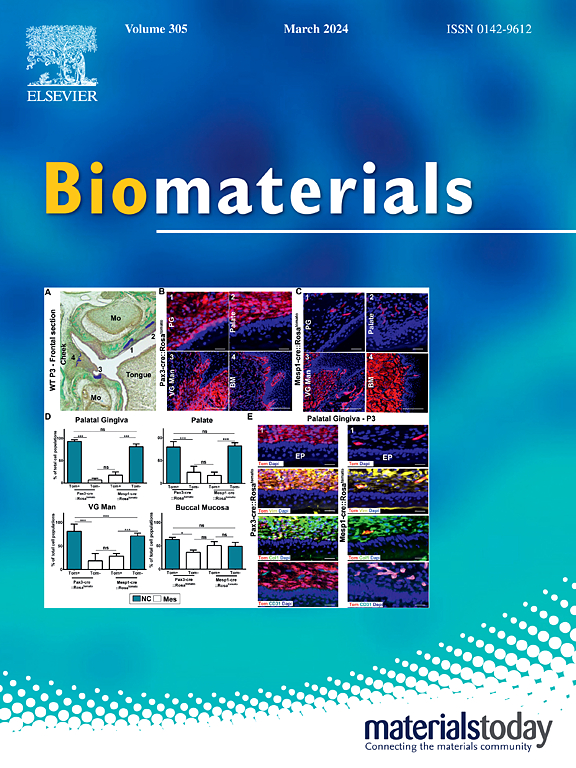Tenascin-c functionalised self-assembling peptide hydrogels for critical-sized bone defect reconstruction
IF 12.9
1区 医学
Q1 ENGINEERING, BIOMEDICAL
引用次数: 0
Abstract
Critical-sized bone defects cannot heal spontaneously and receive poor clinical prognosis due to limitations in modern treatment strategies. Next-generation therapies are applying biomaterials incorporating BMP-2 to effectively promote and support bone regeneration, but adverse effects are linked to uncontrolled BMP-2 egress from the biomaterial. Implementing extracellular matrix proteins to biomaterials is a favourable approach to alleviate these drawbacks, and self-assembling peptide hydrogels are rapidly emerging as modulable and versatile biomaterials. Here, we describe the creation of a tenascin-c-functionalised peptide hydrogel designed to regenerate critical-sized bone defects. A recombinant fragment of tenascin-c spanning from the 3rd to 5th fibronectin-like domains is integrated into the fibre network. We demonstrate that this nascent construct effectively retains BMP-2 to differentiate mesenchymal stem cells into mature osteoblasts and achieves complete unionisation of murine critical-sized bone defects under low BMP-2 dose. All in all, we demonstrate tenascin-c as a suitable candidate to functionalise biomaterials intended for bone engineering applications and the promising potential of self-assembling peptide hydrogels in treating critical-sized bone defects.
用于临界尺寸骨缺损重建的tenascin功能化自组装肽水凝胶
由于现代治疗策略的限制,临界大小的骨缺损不能自发愈合,临床预后较差。下一代疗法正在使用含有BMP-2的生物材料来有效地促进和支持骨再生,但不良反应与生物材料中BMP-2不受控制的释放有关。将细胞外基质蛋白植入生物材料是缓解这些缺陷的一种有利方法,自组装肽水凝胶正迅速成为可调节和通用的生物材料。在这里,我们描述了一种腱蛋白c功能化肽水凝胶的创建,旨在再生临界大小的骨缺陷。tenascin-c横跨第3到第5个纤维连接蛋白样结构域的重组片段被整合到纤维网络中。我们证明,这种新生结构有效地保留了BMP-2,使间充质干细胞分化为成熟的成骨细胞,并在低BMP-2剂量下实现了小鼠临界大小骨缺陷的完全愈合。总而言之,我们证明了tenascin-c是用于骨工程应用的功能化生物材料的合适候选者,以及自组装肽水凝胶在治疗临界尺寸骨缺陷方面的巨大潜力。
本文章由计算机程序翻译,如有差异,请以英文原文为准。
求助全文
约1分钟内获得全文
求助全文
来源期刊

Biomaterials
工程技术-材料科学:生物材料
CiteScore
26.00
自引率
2.90%
发文量
565
审稿时长
46 days
期刊介绍:
Biomaterials is an international journal covering the science and clinical application of biomaterials. A biomaterial is now defined as a substance that has been engineered to take a form which, alone or as part of a complex system, is used to direct, by control of interactions with components of living systems, the course of any therapeutic or diagnostic procedure. It is the aim of the journal to provide a peer-reviewed forum for the publication of original papers and authoritative review and opinion papers dealing with the most important issues facing the use of biomaterials in clinical practice. The scope of the journal covers the wide range of physical, biological and chemical sciences that underpin the design of biomaterials and the clinical disciplines in which they are used. These sciences include polymer synthesis and characterization, drug and gene vector design, the biology of the host response, immunology and toxicology and self assembly at the nanoscale. Clinical applications include the therapies of medical technology and regenerative medicine in all clinical disciplines, and diagnostic systems that reply on innovative contrast and sensing agents. The journal is relevant to areas such as cancer diagnosis and therapy, implantable devices, drug delivery systems, gene vectors, bionanotechnology and tissue engineering.
 求助内容:
求助内容: 应助结果提醒方式:
应助结果提醒方式:


